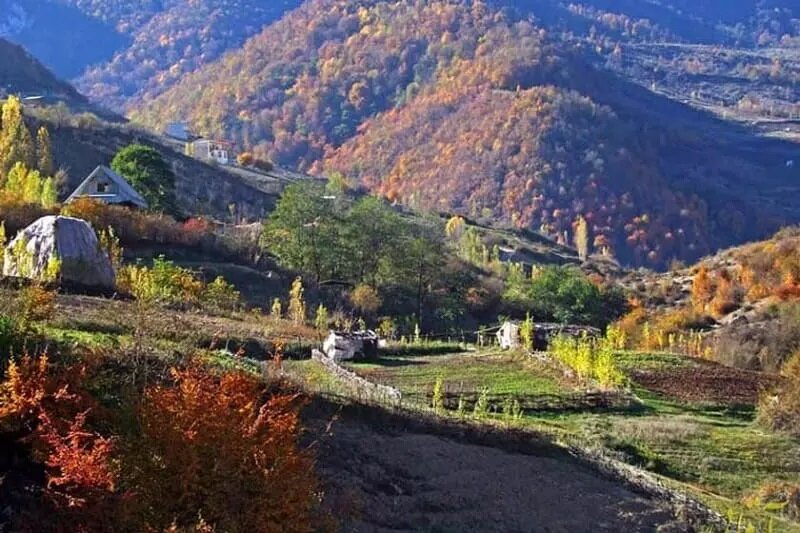Discovering Iran's hidden gems: six lesser-known villages worth visiting

TEHRAN- The vast country of Iran is home to charming villages that offer a unique, tranquil escape from bustling urban life. Many of these villages remain largely undiscovered by tourists, providing an authentic experience amid stunning natural beauty.
Here is a list of six hidden gems that showcase Iran's rich culture, hospitality, and unspoiled landscapes—perfect destinations for those who seek adventure and serenity in equal measure.
Ziarat, Golestan province
Ziarat, located near the city of Gorgan, northern Golestan province, is a picturesque village renowned for its lush green forests, winding rural roads, and a delightful waterfall that emerges at the village's end. This enchanting settlement is a remnant of the Qajar and Pahlavi eras, characterized by its historical charm and stunning natural beauty.
The best time to visit Ziarat is during mid-spring and early summer when the weather is pleasantly mild. At an altitude of 1,000 meters above sea level, visitors can enjoy the refreshing cool breeze, particularly in the mornings and evenings. The welcoming locals are known for their hospitality, and the presence of a revered shrine in the village adds to its cultural significance. Ziarat promises an escape into serenity, allowing travelers to leave behind the noise of city life. For those planning to visit Golestan province, Ziarat is a must-visit stopover.
Meymand, Kerman province
For history enthusiasts, Meymand offers a captivating glimpse into Iran's ancient past. This village is famous for its unique cave homes carved into the mountains, providing an extraordinary architectural marvel. Registered as a UNESCO World Heritage Site in 2015, Meymand is considered one of the earliest human settlements in the country, dating back thousands of years.
With a moderate mountainous climate, Meymand is best explored in mid-spring. The region's vegetation consists mostly of low shrubs and scattered forest trees, creating a naturally beautiful backdrop for hiking and exploring. The primary agricultural products grown here include walnuts, almonds, grapes, and pears, which thrive in the lush valleys and near springs surrounding the village. Visiting Meymand not only allows you to explore its caves but also enjoy a taste of traditional Iranian rural life.
Filband, Mazandaran province
Located in the clouds, Filband is one of the most captivating villages in Iran. Situated at a high altitude, travelers can experience the surreal sight of clouds passing below them, creating a dreamlike atmosphere. On clear, sunny days, the panoramic views of lush green fields and enchanting forests surrounding the village are truly extraordinary.
The village's serene setting makes it a perfect getaway from the fast-paced urban lifestyle. Witnessing the sunrise or sunset from Filband is an unforgettable experience, especially when the sunlight bathes the clouds in stunning colors. The ideal times to visit the village are during spring and summer when nature is at its most vibrant.
Hajij, Kermanshah province
Hajij, located just 34 kilometers from the city of Paveh in western Kermanshah province, is renowned for its picturesque scenery and pleasant climate. Nestled in a verdant valley, this enchanting village is characterized by its welcoming atmosphere and natural beauty.
The best times to visit Hajij are during the spring and summer months, when the weather is ideal for exploration. The village is surrounded by a plethora of attractions, including Khanqah (a place of spiritual retreat), the serene Hoz-e Pir, the picturesque Sirvan River, and the charming Bal Spring. A visit to Hajij offers travelers an opportunity to witness Iran's rural charm and cultural heritage.
Atashgah, Chaharmahal-Bakhtiari province
Atashgah is one of Iran's least-known villages, located in the Lordegan district, southwestern Chaharmahal-Bakhtiari province. This brilliant and unique village has an intriguing history linked to the Qajar era, characterized by its stunning buildings and rich cultural heritage.
Atashgah can be visited in four seasons, with its beauty thriving all year round. Regardless of when you visit, the village's appeal will leave you in awe. A highlight of Atashgah is the magnificent Atashgah Waterfall, considered the tallest waterfall in Iran. Other attractions include the nostalgic Mehdikhani Hill, the ancient Imamzadeh Pir Piran shrine, and the majestic Do Berar Peak. Atashgah offers an unmatched experience and connection to nature, history, and local culture.
Ista, Alborz province
Located in the Alborz province, Ista is renowned for its extraordinary culture and peculiarities. Famous for breeding high-value horses, this village is shrouded in mystery—its residents conduct no celebrations such as weddings or birthdays and even abstain from commemoration events. Intriguingly, women are not allowed to enter Ista, making it unique among Iranian villages.
With no public utilities such as running water, electricity, or gas, the village maintains its traditional lifestyle, and the inhabitants do not possess identification documents. This mystique adds to Ista's allure as a destination for travelers with curious spirits. The best time to visit is during summer or spring when nature flourishes, providing breathtaking views and experiences. Exploring Ista allows visitors to witness the untamed beauty of the Taleqan region, rich in natural charm.
These six Iranian villages—the haven of Ziarat, the historical marvel of Meymand, the cloud-kissed Filband, the picturesque Hajij, the unique Atashgah, and the mysterious Ista—embody the country’s cultural richness, breathtaking landscapes, and warm hospitality.
Each village offers a distinctive flavor of rural life, inviting curious travelers to immerse themselves in the beauty and serenity of Iran’s untouched nature.
For anyone seeking a break from the hustle and bustle of city life or looking to explore the hidden gems of Iran, these villages are the perfect destinations for an unforgettable adventure. Each is a testament to the country’s diverse landscapes and traditions, waiting to be discovered and cherished by travelers from around the world.
Photo: A view of northern village of Ziarat
SAB/
